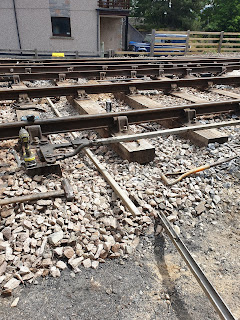(Or to giving it, it’s informal name Morley’s shed)
20 June 2020
It has been nice this weekend to be out on the engineering squad.
Working along side the P-ways squad this weekend has been refreshing, to be working along side other people and to receive help digging holes as well as back filling has been a great change . It has been interesting seeing the effort which has gone into making physical distancing possible with in the work space. Whether it was questioning what was needing worked on or who was able to access the various site next , it highlighted that even though the work process is slightly different it’s certainly not impossible.
 |
Start of the day! All the holes have been dug and stools repaired on my passing visits. We were now ready to put the cranks down and put the rodding in and see how much we can complete today.
First job was putting the compensator crank down. Currently sitting in it’s mid stroke position, in this picture. For those who do not understand the reason why we use this crank...Well it is very clever! With out this the points system will just not work. With the temperature variants the rodding is broken into two parts “push” and “pull. The compensator crank is very clever and changes a “push” movement into a “pull”movement. So why do we have half of the rodding as push and the other as pull? Simple! to equalise expansion and contraction. As long as both are equal in length and warm and cool at the same rate then both remain the same length all the time. This way we do not have to constantly make adjustments to the points to make them work.
This is the sleeve crank being positioned, set at 90 degrees, or mid stroke this is standard practice when setting up or making adjustments to a mechanical points setup. It’s not as easy as you think! You need to keep it in the mid stoke position. Get the “sleeve” in line with the drive rod on the points. Plus get the hole on the other side to line up with the rodding run. In this case 610mm from the inside of the rail. Otherwise you will end up with extra resistance and make the points heavy for the signaller to operate!
And the last thing I want is “more” grumpy signallers.
Today I was given some help from Angus. Between the two of us we started to put the rodding in. Lifting and packing and slewing. Very similar to P-way techniques. 140mm above the sleepers and 610mm from the inside of the rail profile. Takes a bit of time but well worth the effort. The better the line the easier it is for the signaller to operate. Plus it makes it look better as well.
Missed a couple of pictures at this point! The rodding has all been installed, closures been cut. If you look at the A end of the points you can see that they are set half way. The sleeve crank closest in the picture is also set in mid stroke/position. At this point we were ready to make the last cut and put the closure rod in from the points drive rod, (with the B end of points sitting half open) to the sleeve crank. Mid opening for This type of points is 54mm fully open is 108mm.
The last rod cut to size and pilot holes drilled. Now to offer it up and well, yes see if it fit! Thankfully it fitted perfectly.
Angus looking over quite happily “I think”, at the work that we have done today. You will notice the threaded bar that has been installed at the front of the points. This is to act as a sole plate. This makes sure that both stock rails do not move apart from each other, this may lead to the switches not closing properly. Worst case scenario derailment. Next worst scenario someone forgets about it and face plants into the ground! I hope both never happen!
Points Number on, all connected up working well. Will need a bit of usage to bed in. Think even the worst of signaller should be able to operate it easily. Now it is time to start working out the points detection for connecting up the signal out of the yard. Although there is an other day for that.
A end of the points looking down into the job. With the SGE type HJ electrical detector sitting loosely in place. Points guards still to be mounted and points numbers in place. Need to drill out for the nails! Jarrah wood 8 - nails zero!
So overall a very good day with the points in a usable condition. Although the interlocking is still not done. Until then the points will remain clamped, scotched and locked out of use. This ensures the safety of any trains that may run over the points in the short term future.
Here is a quick look at what goes into the design of the rodding run.
This is only the points rodding ,there is a different drawings again for the FPL (facing point lock).









Looking good Rob, we appreciate all the graft that's gone into getting this project up and running,the blogs great too. Keep up the good work.
ReplyDeleteFascinating stuff! Great to understand how it all works!
ReplyDeleteMy goodness, I take my eye off the blog for a couple of weeks and all sorts of stuff happens! It took me a while to read them all and catch up; all your time and energy put into writing them are very much appreciated!
ReplyDeleteNoel